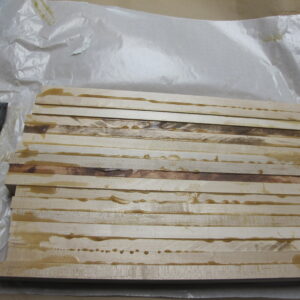Need advice on gluing up wood for cutting boards
I just started making my own cutting boards with maple and cherry wood. when I was gluing my wood pieces together with Titebond 3 glue, I was using a paint brush (didn’t realize the brush had ink/paint reside on it.) to spread the glue across the wood. I should have gotten a clean brush.
Do you think the cutting board is still safe to use? I don’t know if the ink/paint on the brush have contaminated the glue on the cutting board. I didn’t see any ink/paint on the glue as I was brushing glue across the boards. Or should I throw the cutting boards out to be safe and start over?
Thank you for your expertise and advise.















Replies
The ink didn't stain the glue then I would assume that there wasn't much there. I know what ink is and I know what paint is. I have no idea what ink paint is, like sumi ink? I'd put that on my cereal. Your going to put a food friendly finish on the board maybe and then salmonella when you cut the chicken and ecoli from the lettuce so I'd keep on going.
But what a great idea! Ive been trying to dye through thin pieces of wood and failed. I wanted thin black lines between laminations. I finally settled for doing it with walnut. But there you solved it ---- maybe--- dye the glue!
If the glue joints are holding I wouldn't give it another thought.
Nor would I.
Unless you plan on chewing the cutting board, I'm with the others.
Think about the mechanics for a sec. That glue line is maybe a few thousands of an inch. Thus, very little material in the glue is exposed after you plane and sand. Like the others said, I wouldn't worry about it.
A bit off topic, but you certainly didn't starve the joints for glue. Consider getting one of the silicone glue brushes available from Rockler or just about every Woodworking supplier, they are the best option I've found for applying glue and you don't need to wash them when your finished just peel off the hardened glue the next day.
If you're accustomed to using Titebond 1 or Titebond 2, the color difference of Titebond 3 can be shocking. It dries much darker than regular carpenter's glue.
Your picture looks like the normal color of TB3 to my eye.
Mike
The ink, or whatever the colorant is, is entirely encapsulated within the glue line. Once dry, the waterproof Titebond III does not allow any water penetration at all. In order for the colored material to be transferred to food, it would have to be soluble in water or fat; since that can't happen, there is no issue.
We tend to confuse hazard with risk; hazard being the propensity to cause harm. The real issue, risk, also involves exposure, which in the context of toxicology means taking into the body via ingestion, inhalation or absorbsion, a dose sufficient to provoke a response. Nothing to worry about here.
This forum post is now archived. Commenting has been disabled